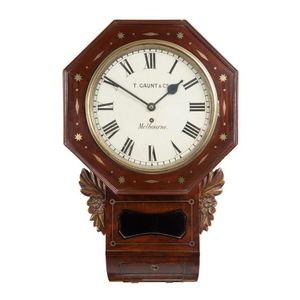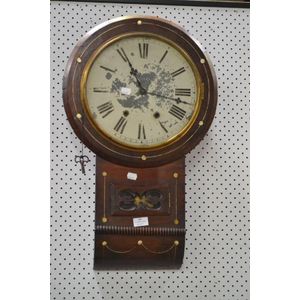Ingrams Walnut Drop Wall Clock with Inlay and Pendulum
Ingrams walnut drop case wall clock. String inlay with Mother of pearl. pendulum. Untested. Estate late Douglas Osborne Hawke. Height 70 cm
You must be a subscriber, and be logged in to view price and dealer details.
Subscribe Now to view actual auction price for this item
When you subscribe, you have the option of setting the currency in which to display prices to $Au, $US, $NZ or Stg.
This item has been sold, and the description, image and price are for reference purposes only.
- Mother-Of-Pearl - Mother-of-pearl, technical name "nacre", is the inner layer of a sea shell. The iridescent colours and strength of this material were widely used in the nineteenth century as an inlay in jewellery, furniture, (especially papier mache furniture) and musical instruments.
In the early 1900s it was used to make pearl buttons. Mother-of-pearl is a soft material that is easily cut or engraved.
Nowadays it is a by-product of the oyster, freshwater pearl mussel and abalone industries. - Pendulum - The pendulum was discovered around 1602 by Galileo Galilei, and was adopted for time keeping by the Dutch mathematician and natural philosopher, Christiaan Huygens, who excelled in astronomy, physics, and horology.
The pendulum comprises a metal rod usually of brass or steel with a metal disk, known as a bob, at the end. The movement of the pendulum is driven by weights or a spring, and as a pendulum swings in a regular arc, it was found accuracy could be controlled to within a few seconds a week.
Timekeeping can be adjusted by changing the height of the bob on the rod, making the pendulum either swing slower or faster.
The disadvantage of the pendulum was that changes in temperature also changed the length of the pendulum, interfering with the accuracy of the clock, and so in the 18th century two types of mercurial pendulums were invented which countered the movement in the steel rod.
The pendulum was the world's most accurate timekeeping technology until the invention of the quartz clock, regulated by a quartz crystal, in 1927.
This item has been included into following indexes:
Visually similar items

A brass inlaid mahogany railway clock, T. Gaunt & Co. Melbourne, 19th century, 66 cm high
Sold by
in
for
You can display prices in $Au, $US, $NZ or Stg.

Antique Ingraham wall clock, 70 cm high approx, key and pendulum included
Sold by
in
for
You can display prices in $Au, $US, $NZ or Stg.

Inlaid Wall clock, has key and pendulum
Sold by
in
for
You can display prices in $Au, $US, $NZ or Stg.

Antique drop dial clock, mother of pearl inlaid rosewood, with key & pendulum, approx 64 cm x 41 cm
Sold by
in
for
You can display prices in $Au, $US, $NZ or Stg.
